
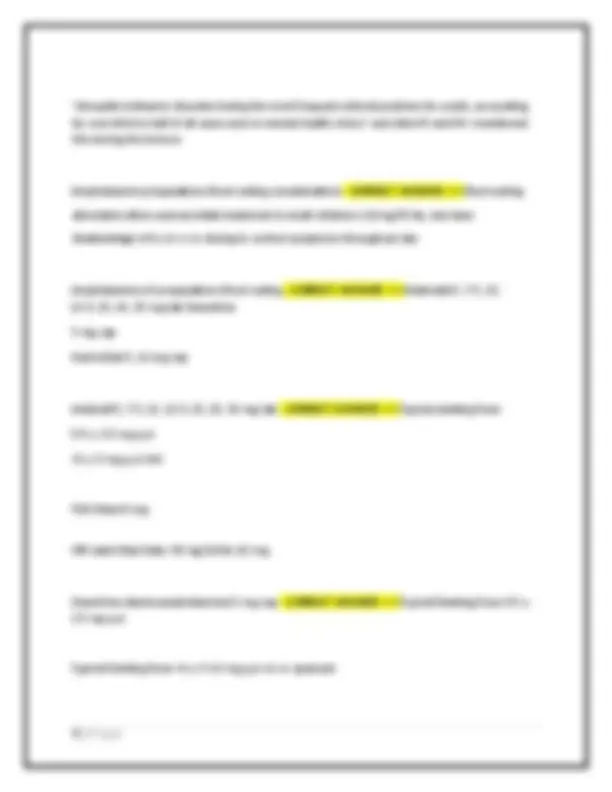
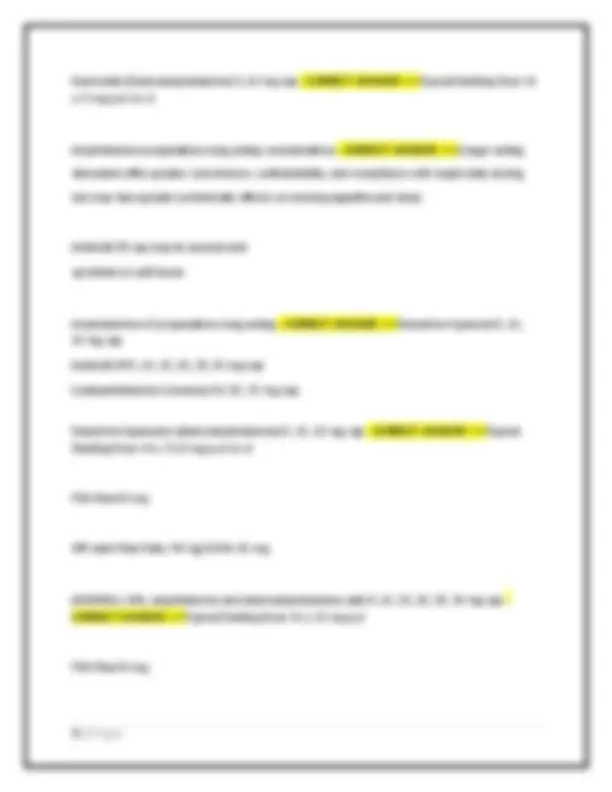
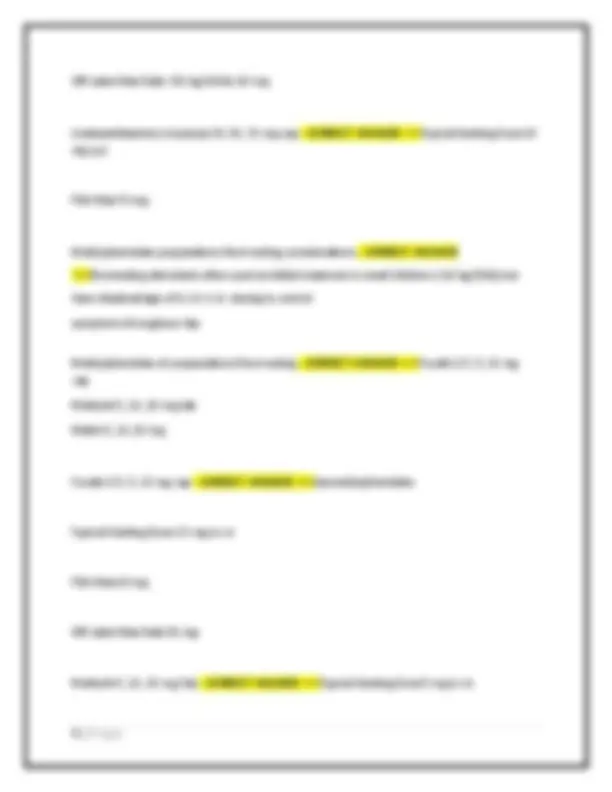
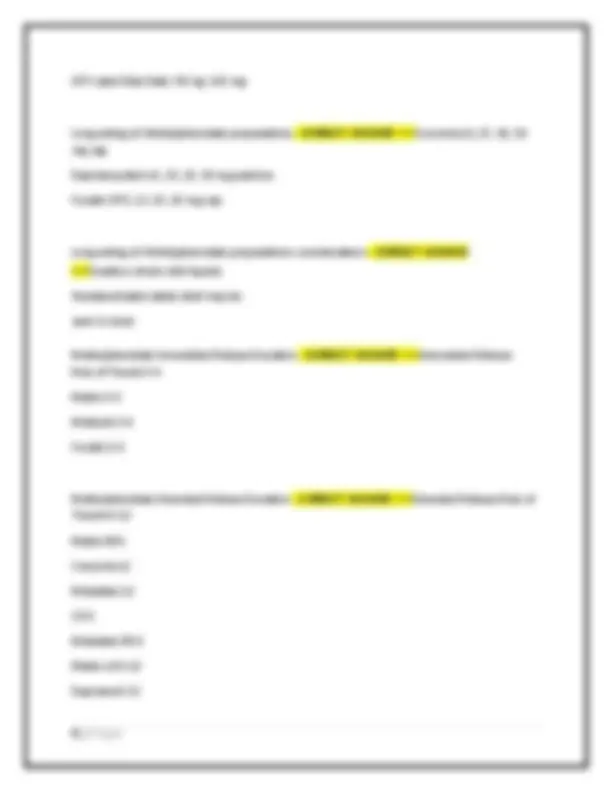
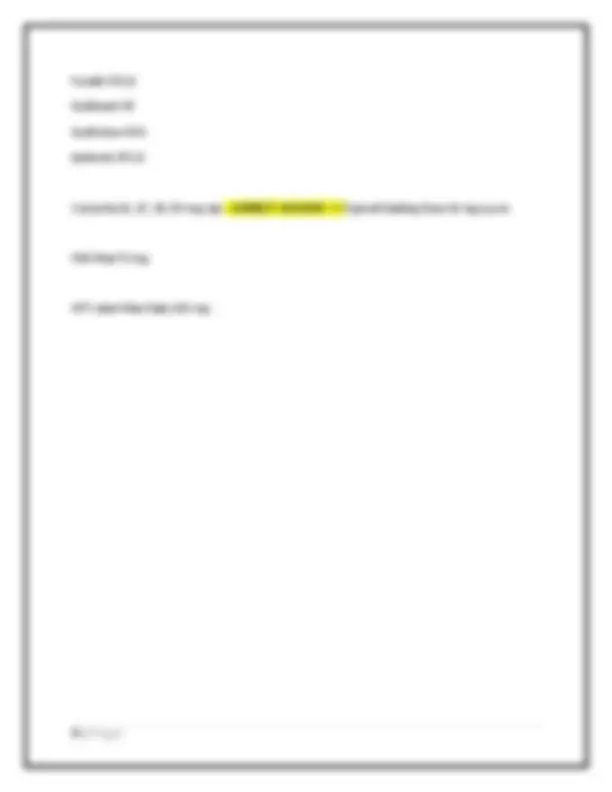
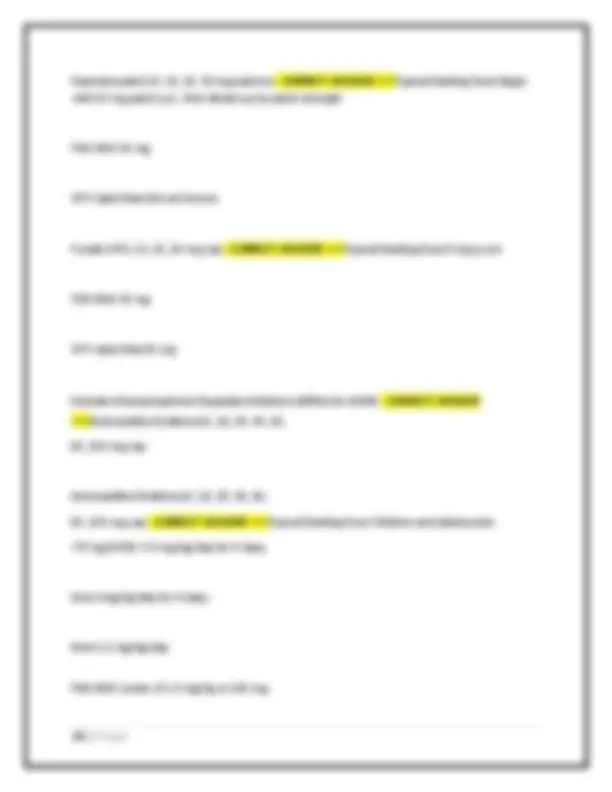
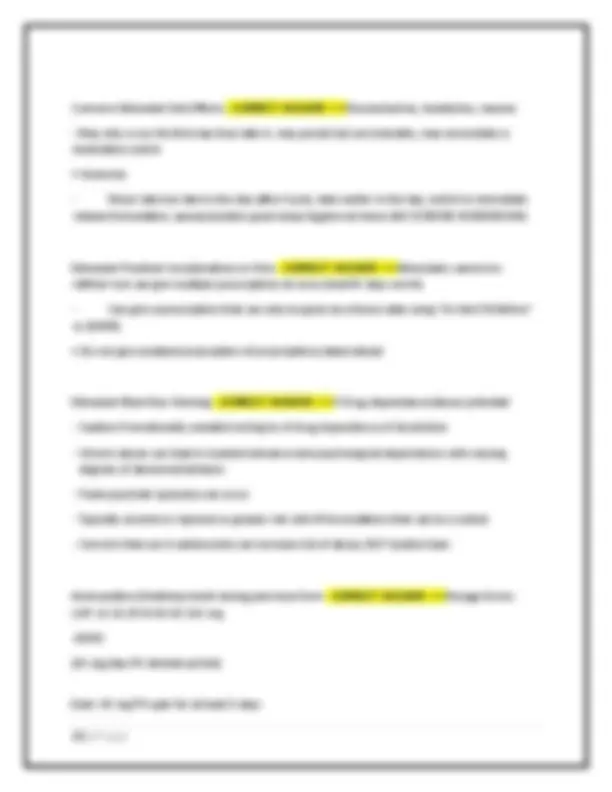
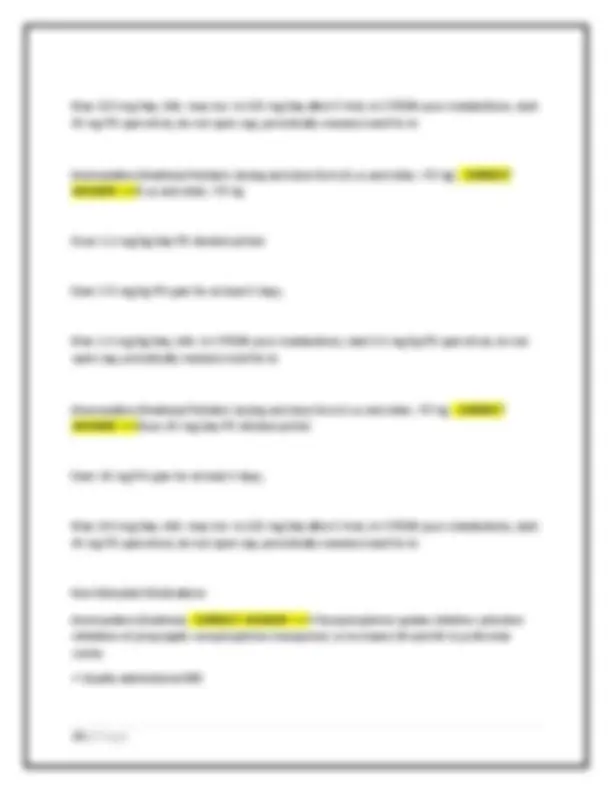
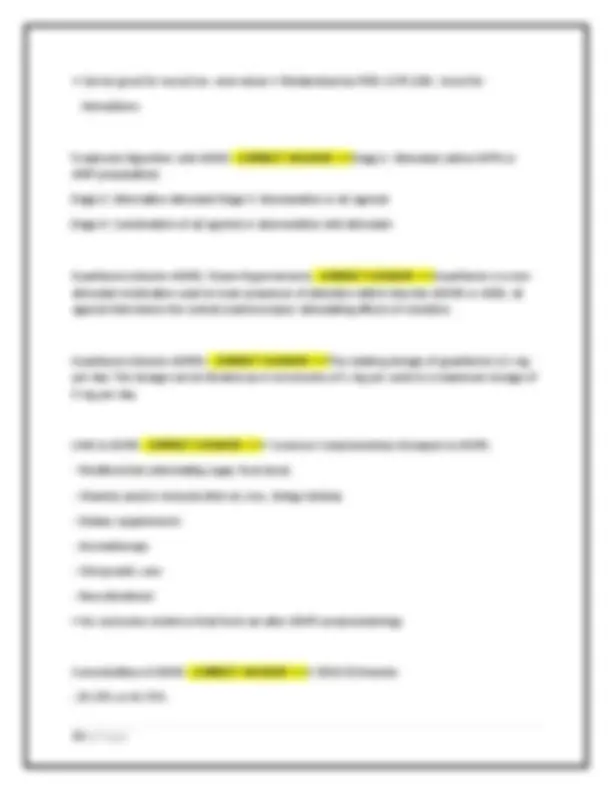
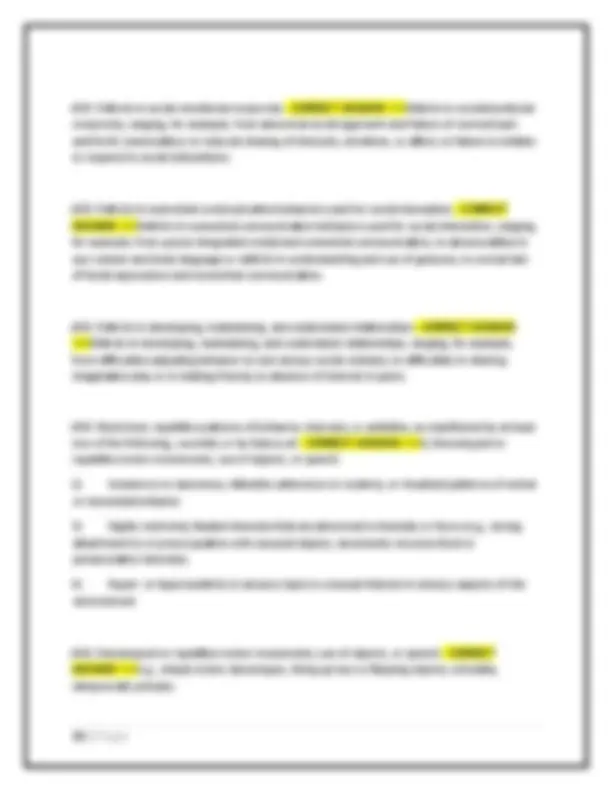
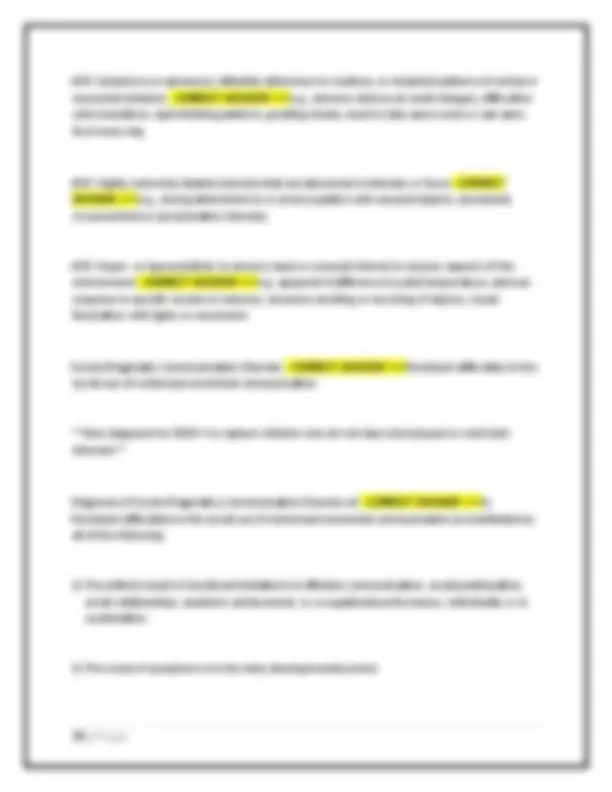
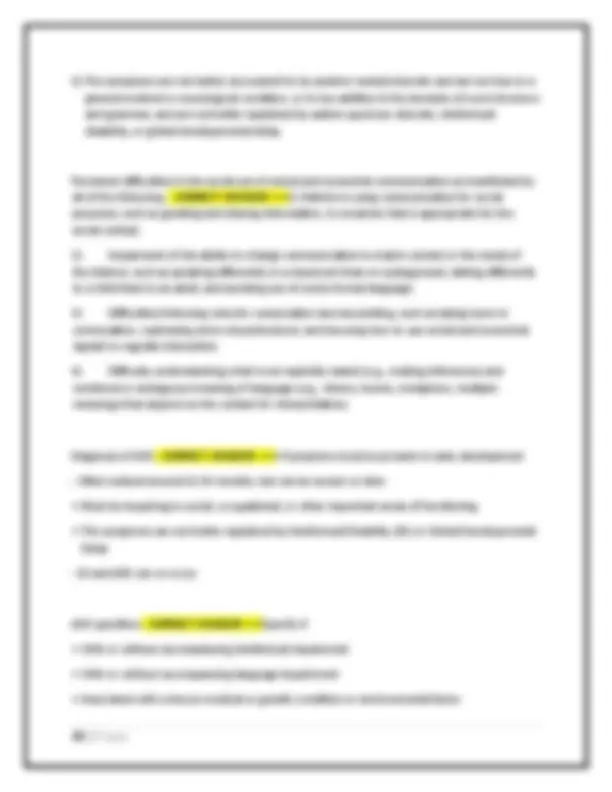
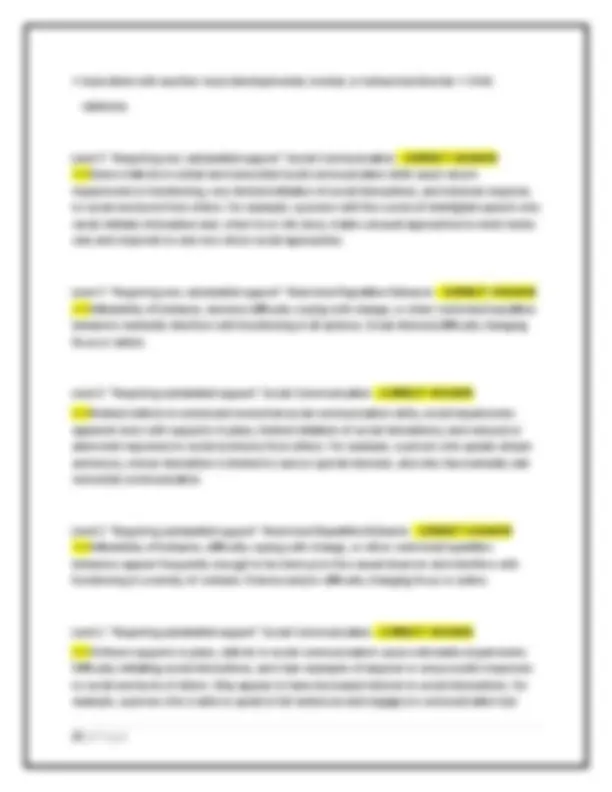
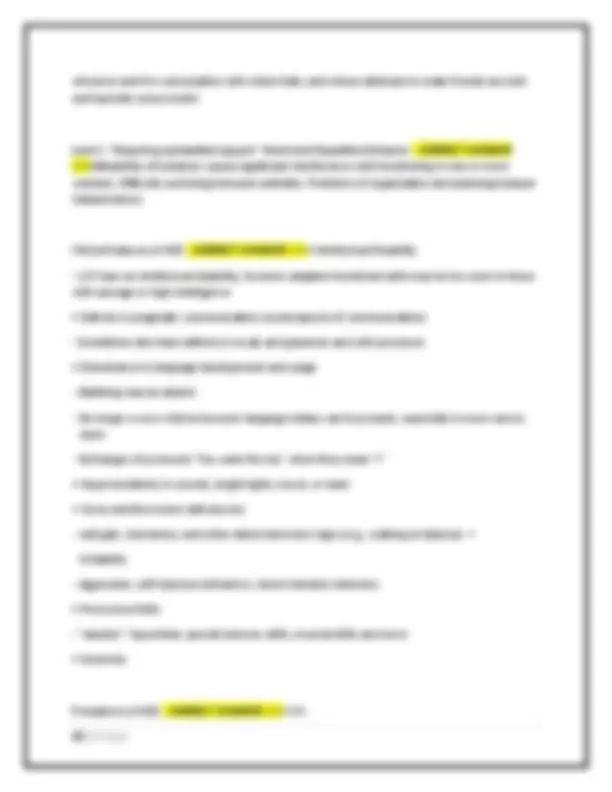
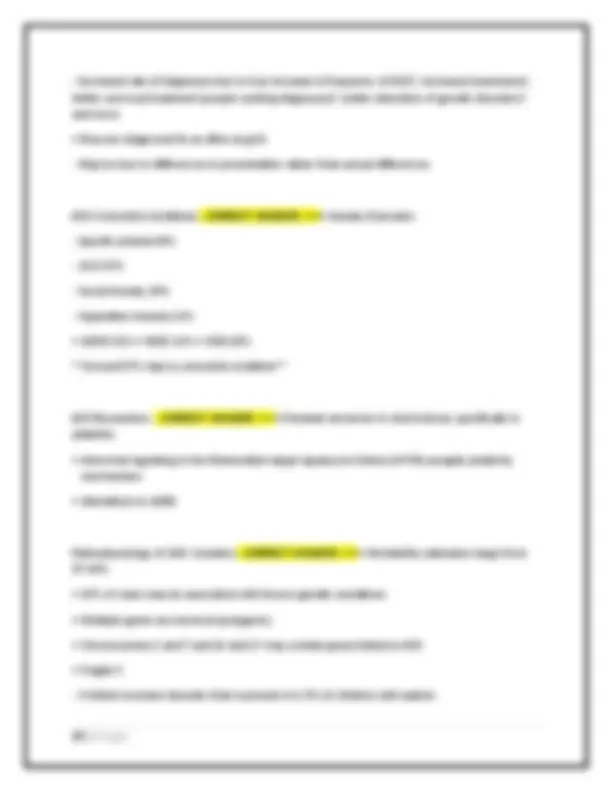
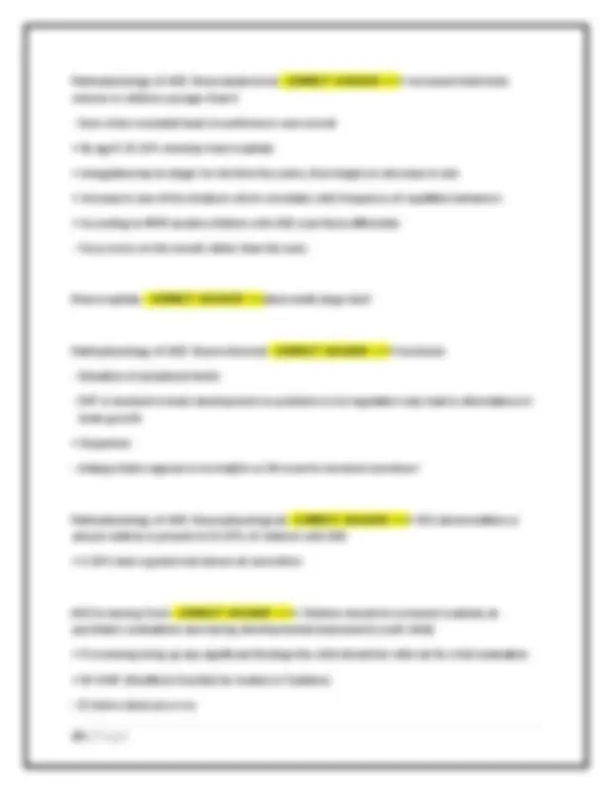
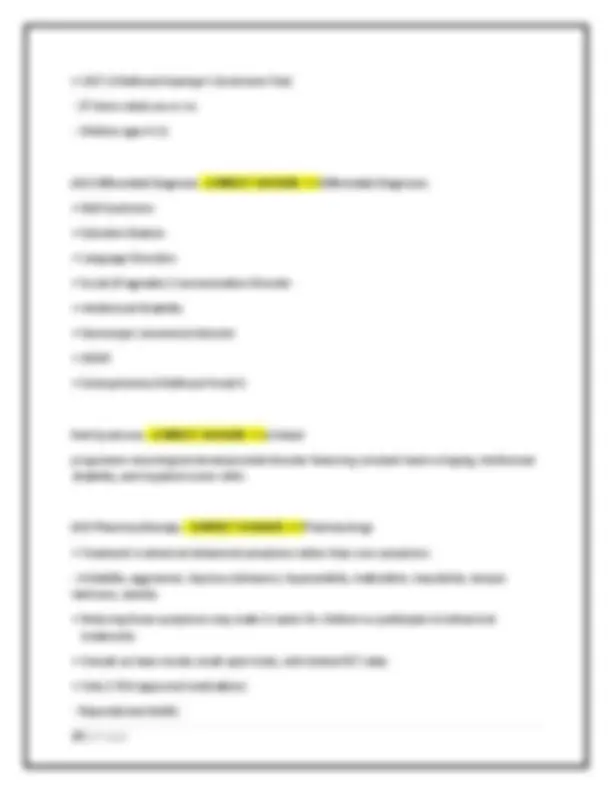
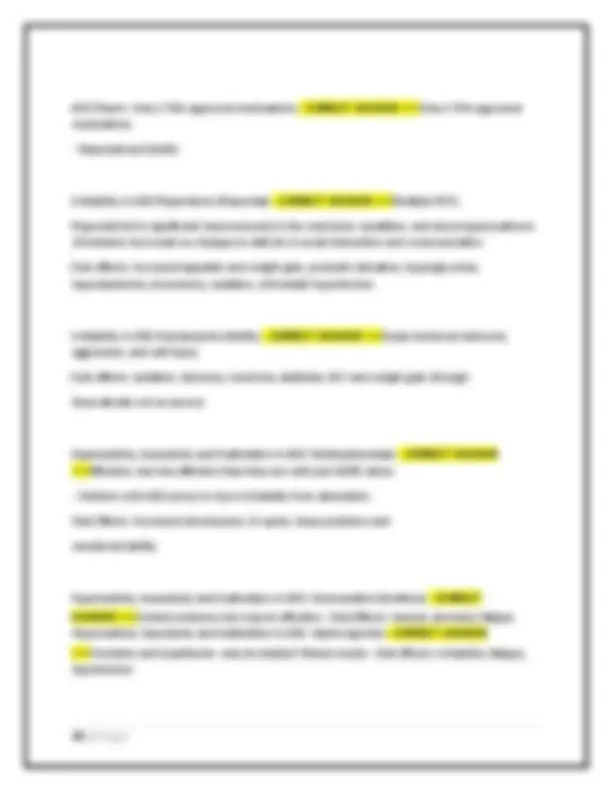
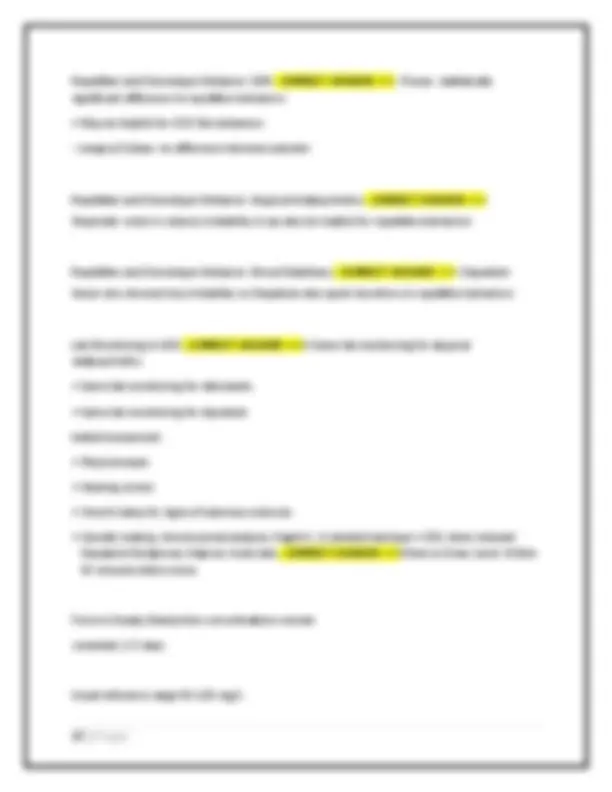
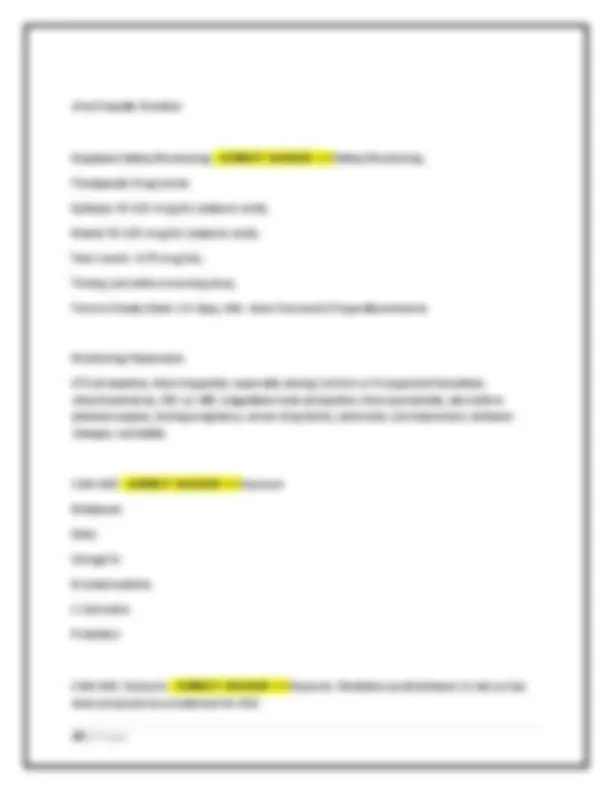
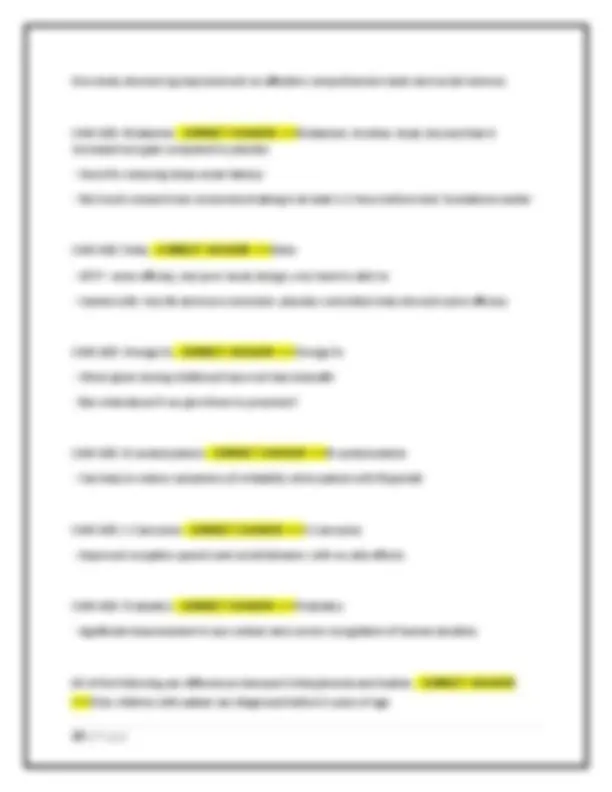
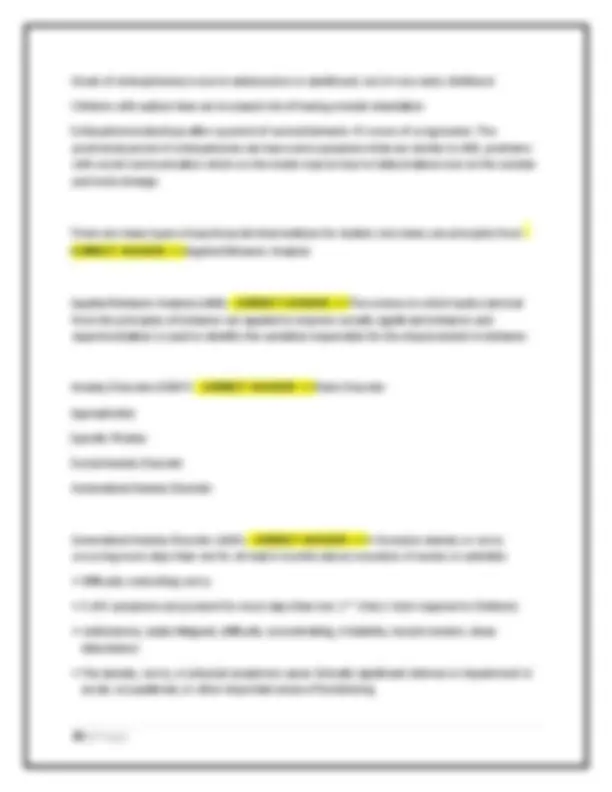
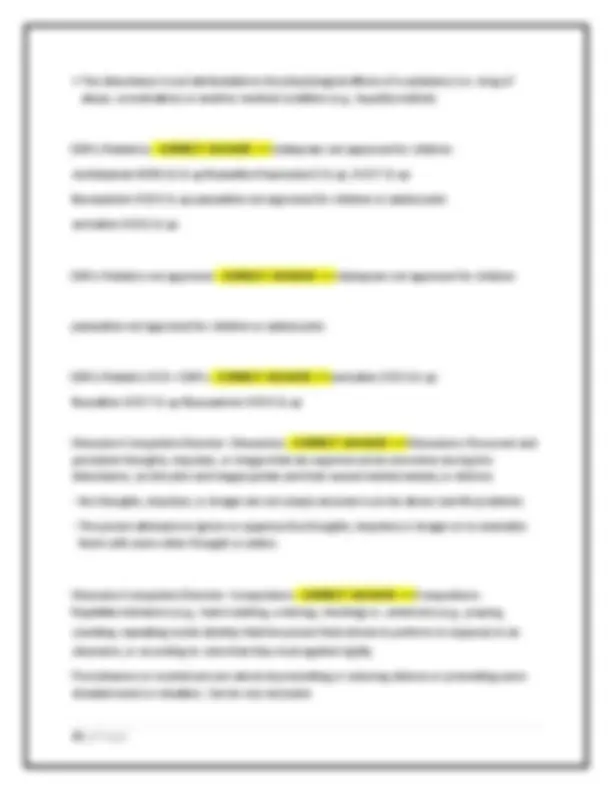
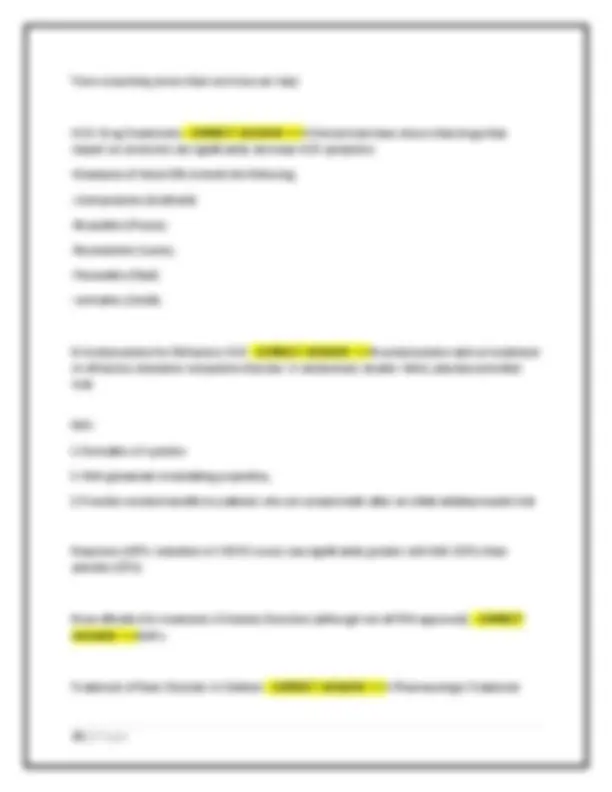
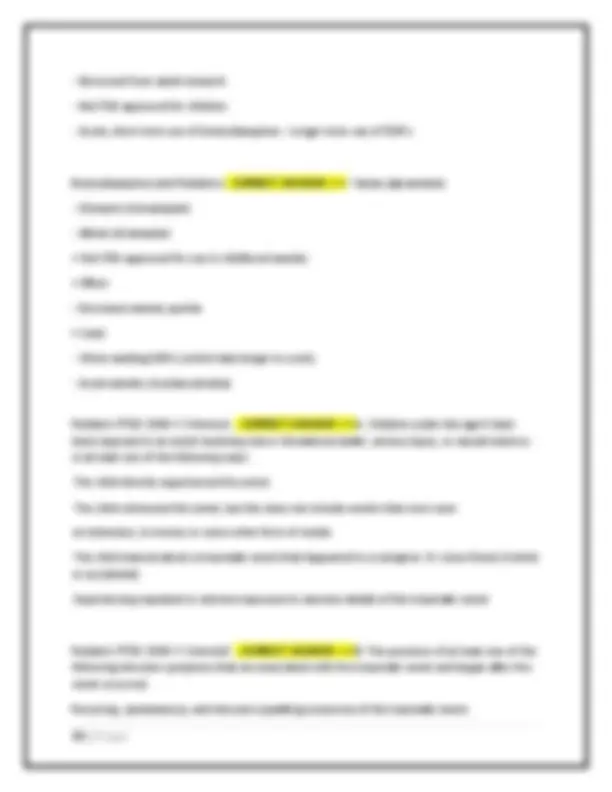
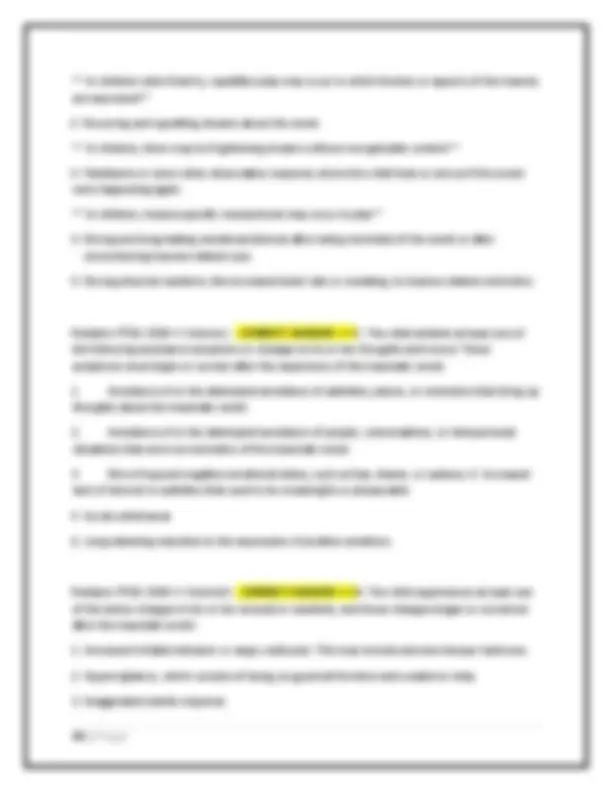
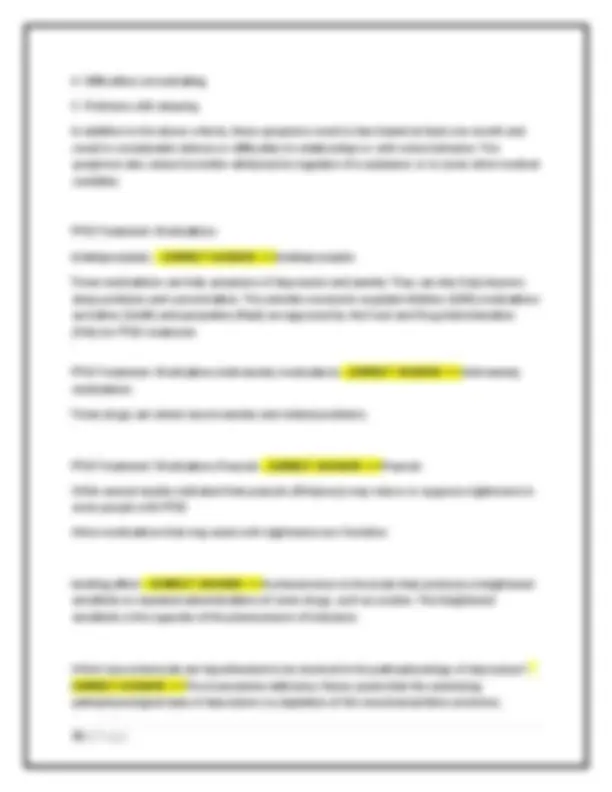
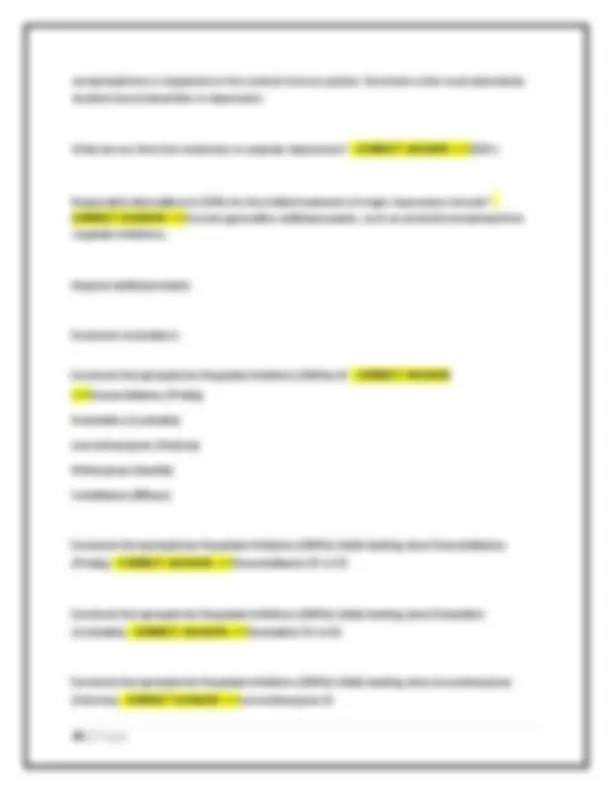
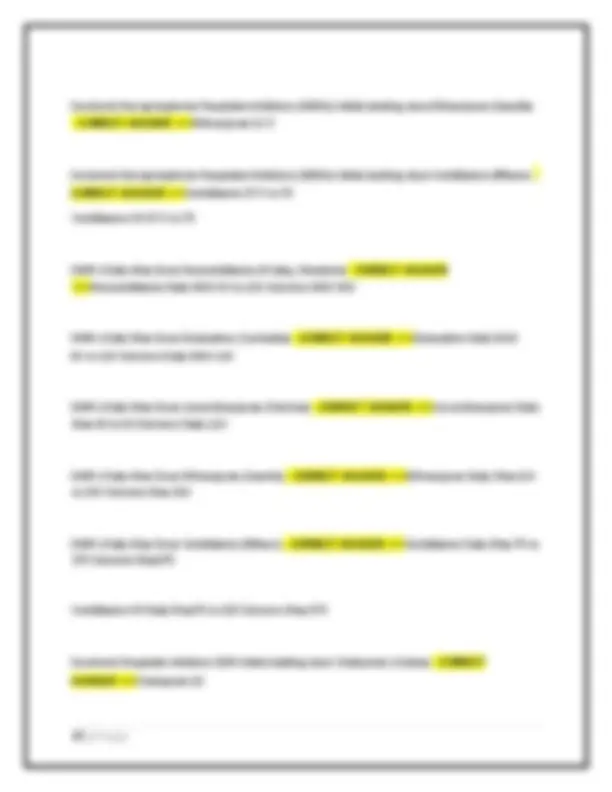
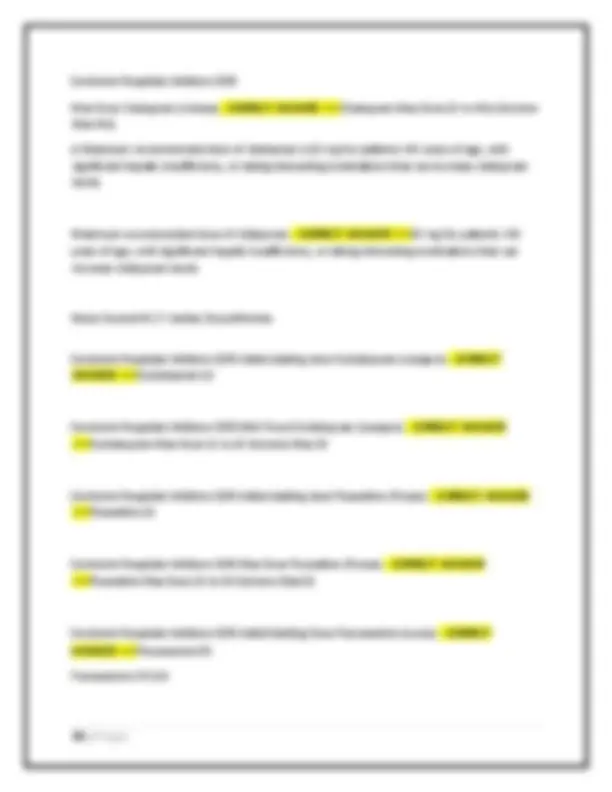
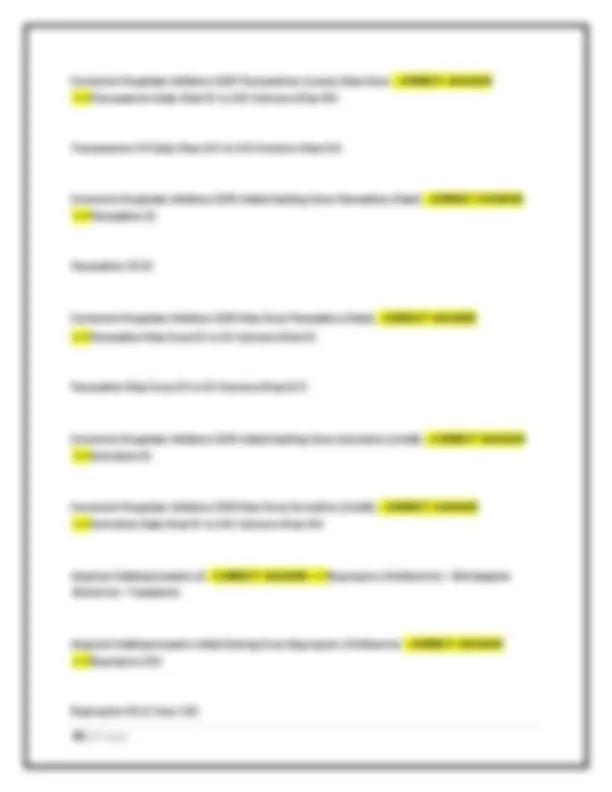
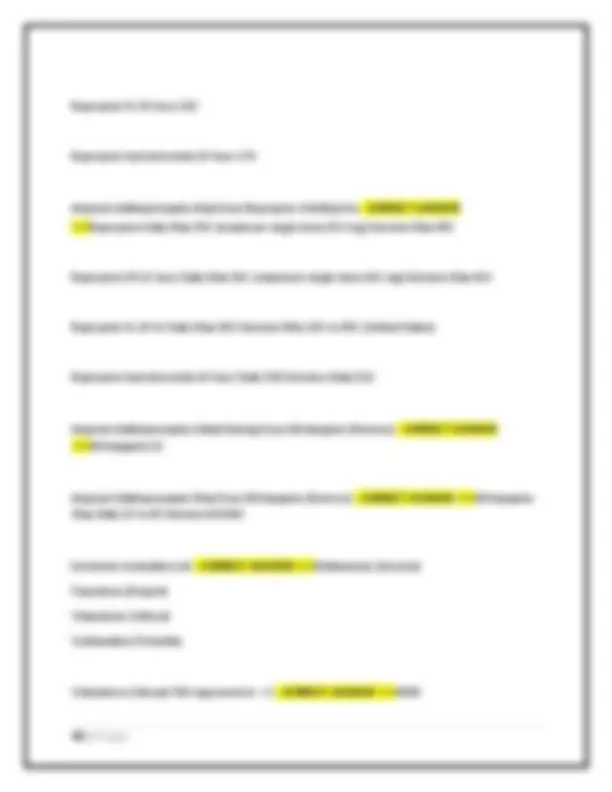
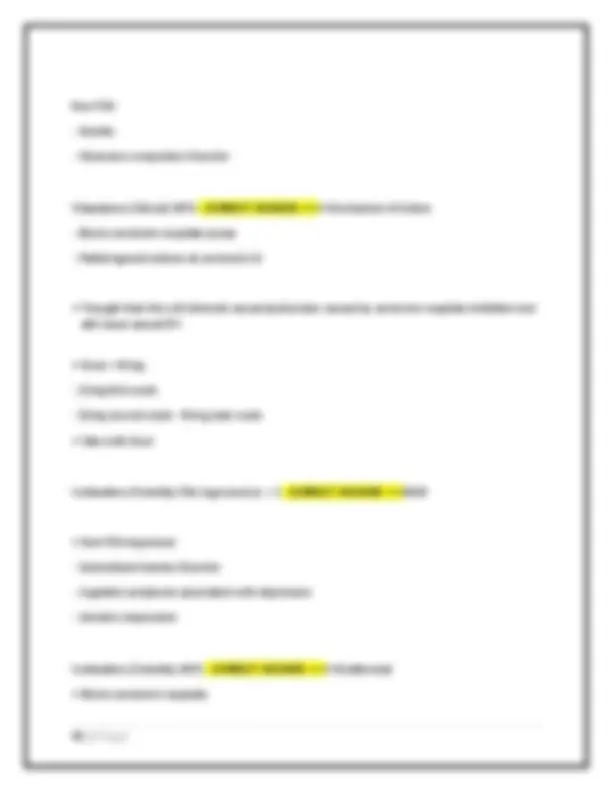
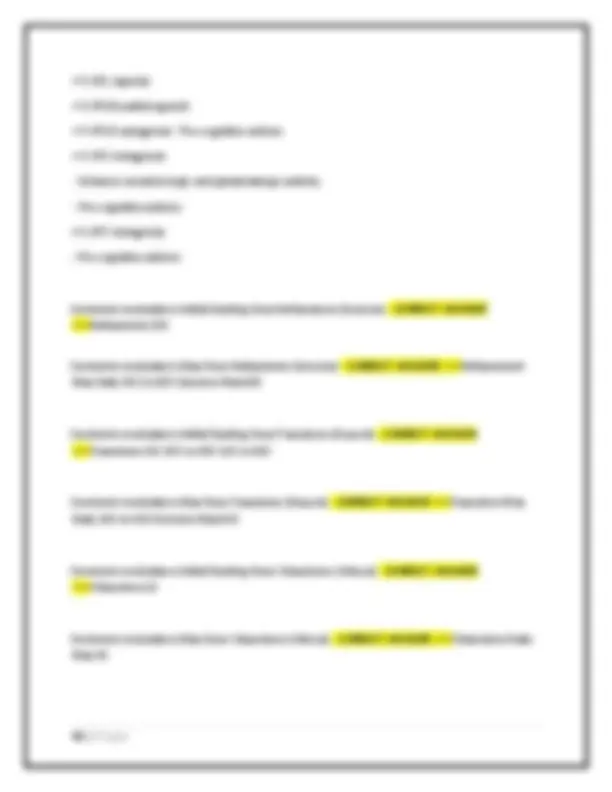
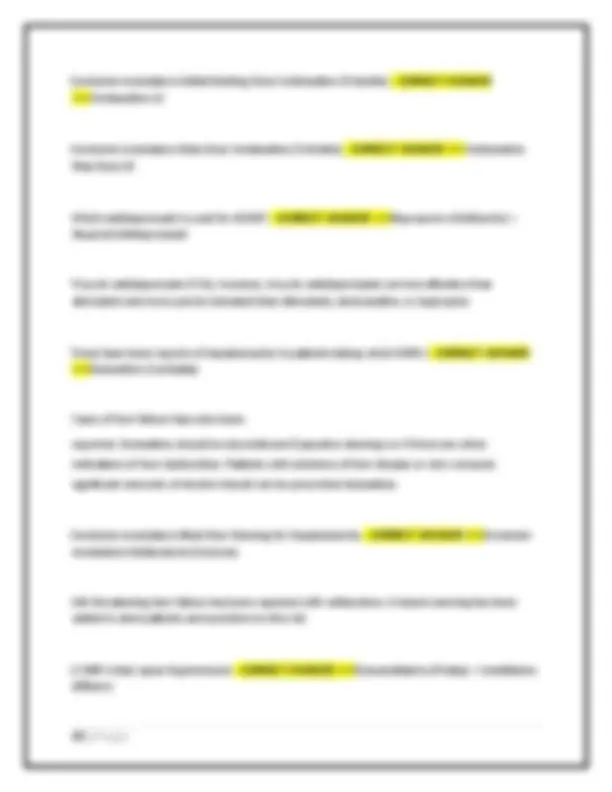
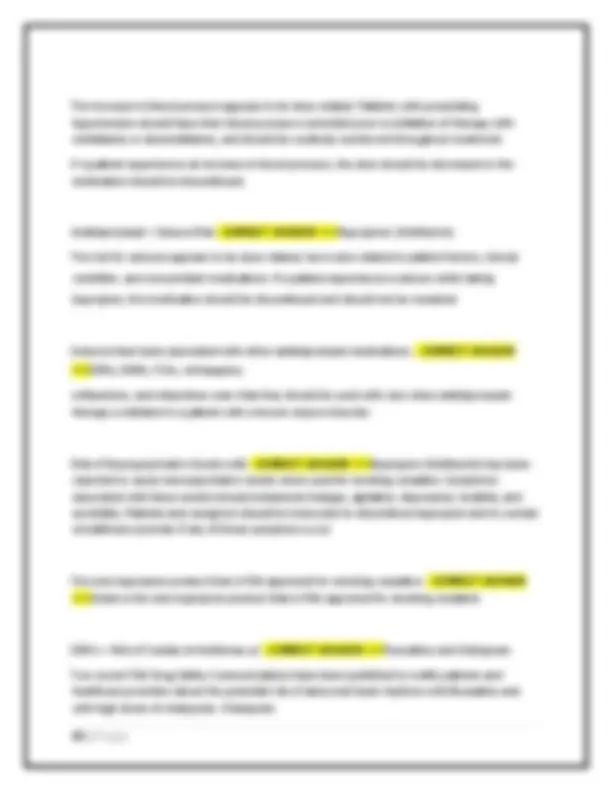
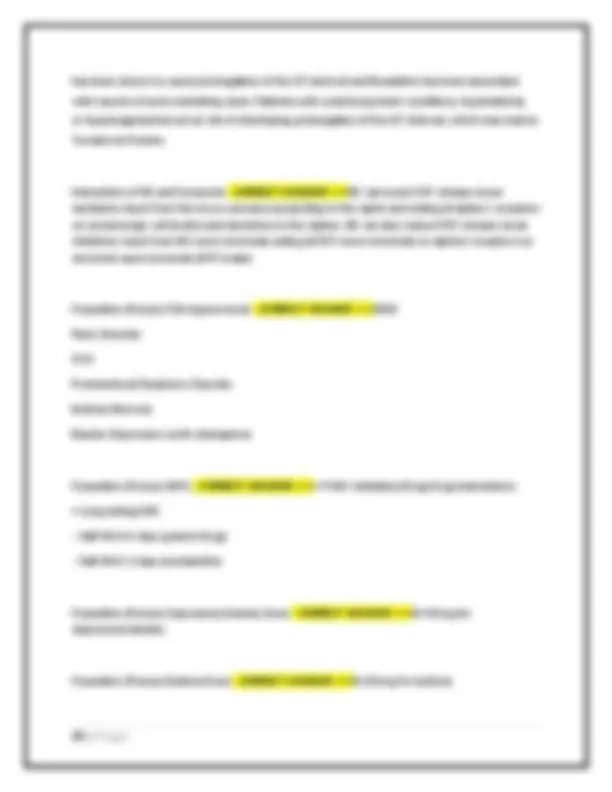
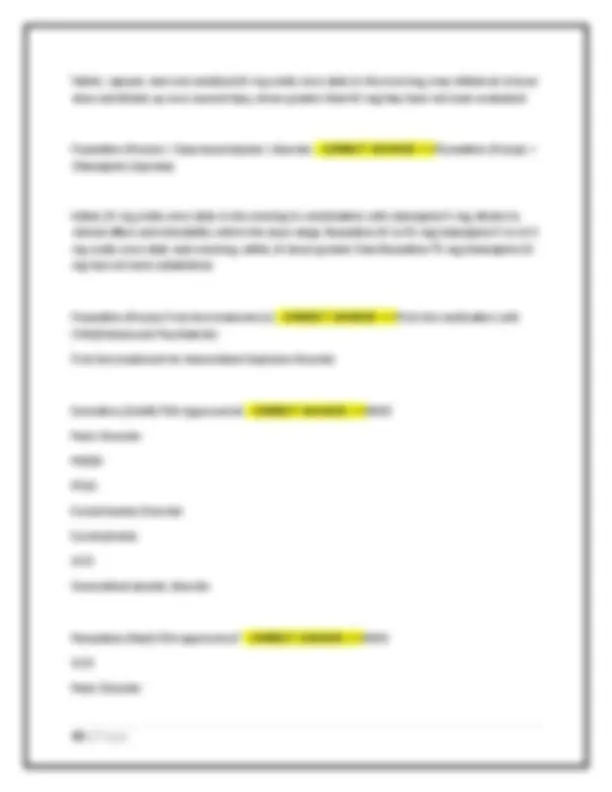
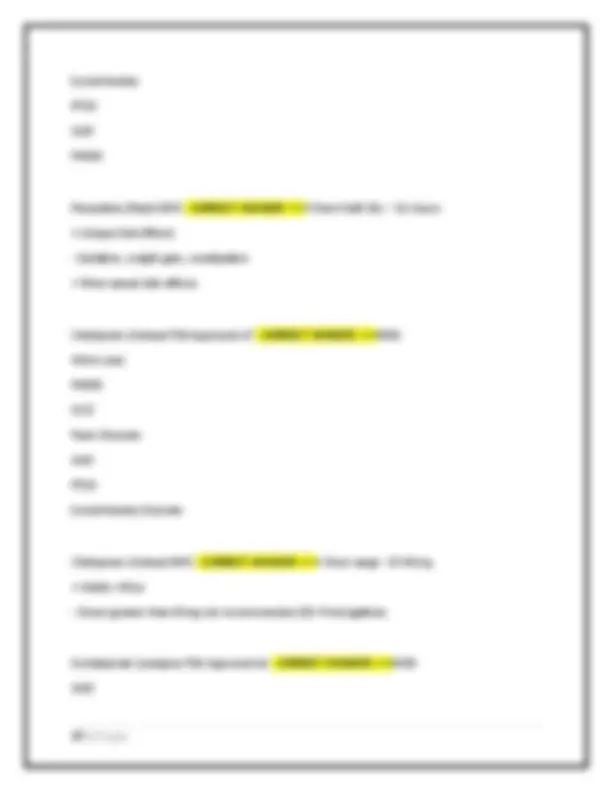
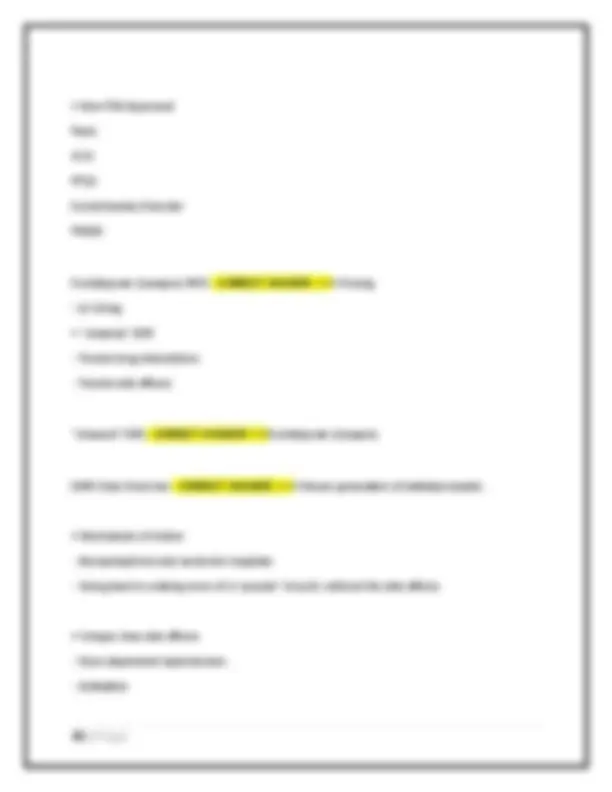
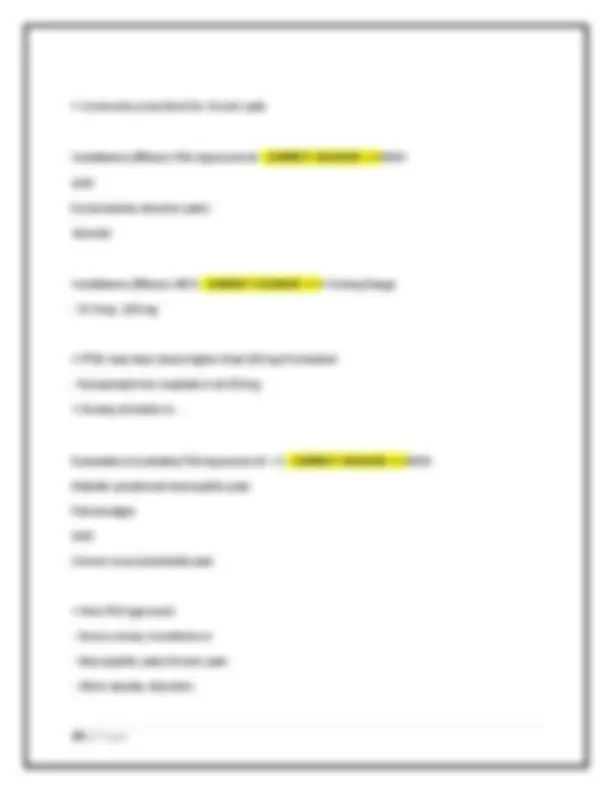
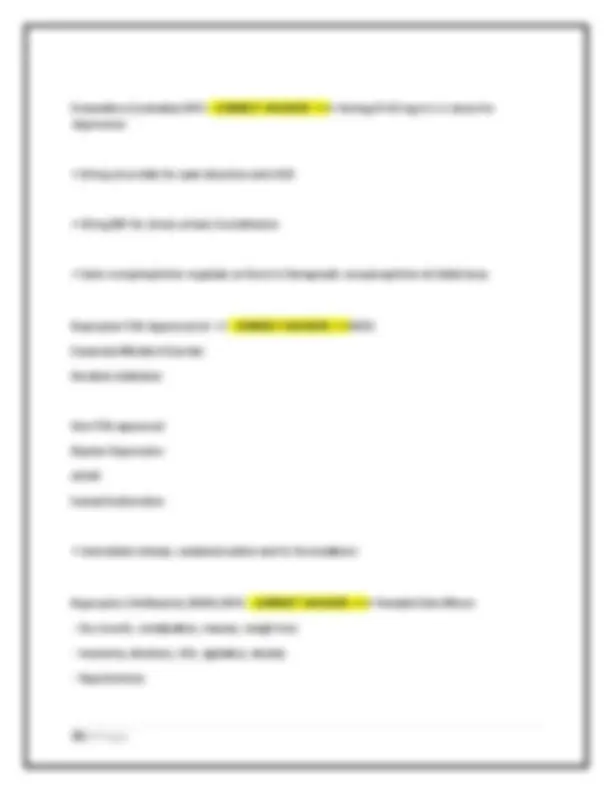
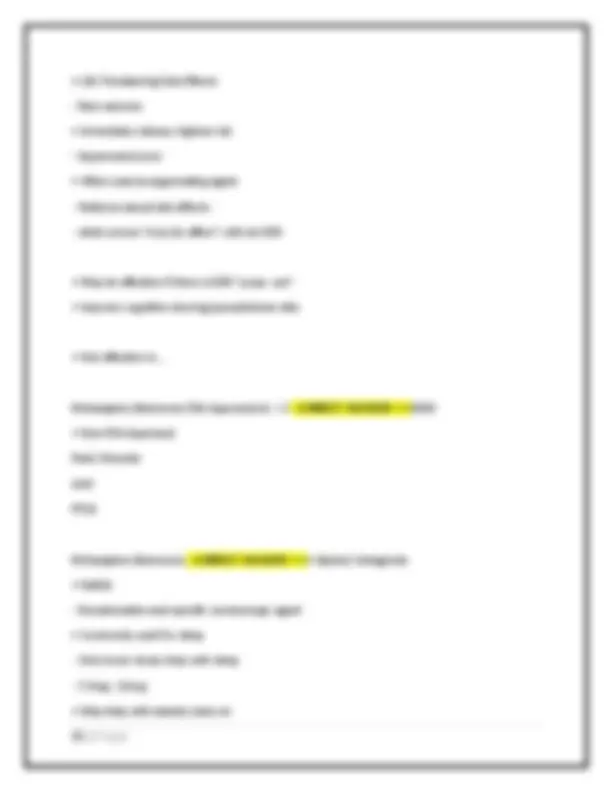
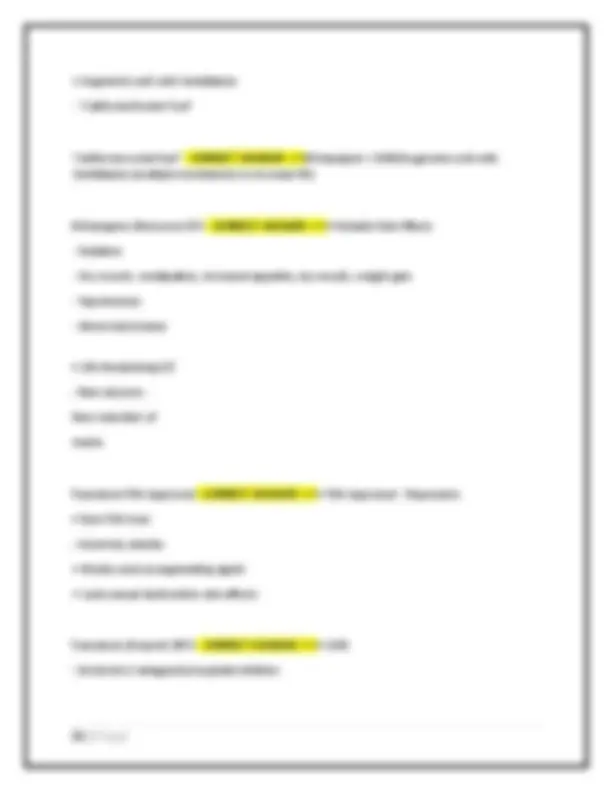
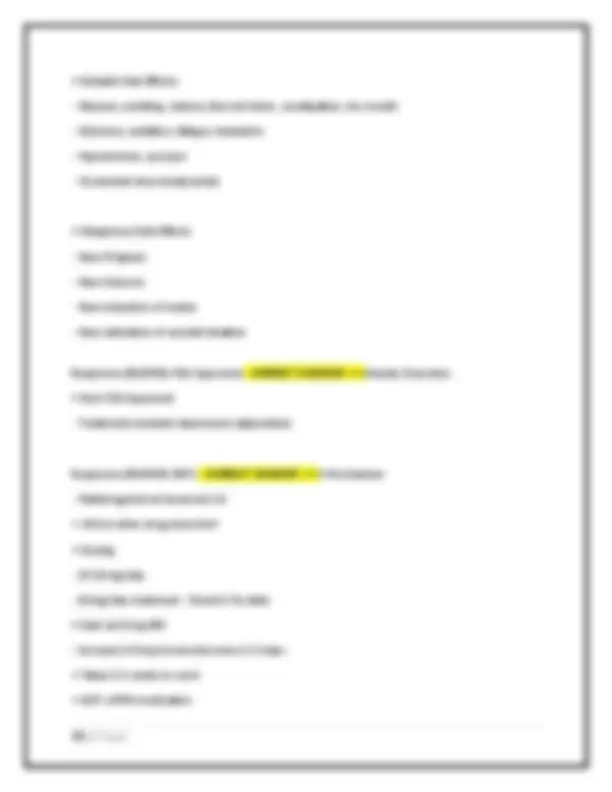
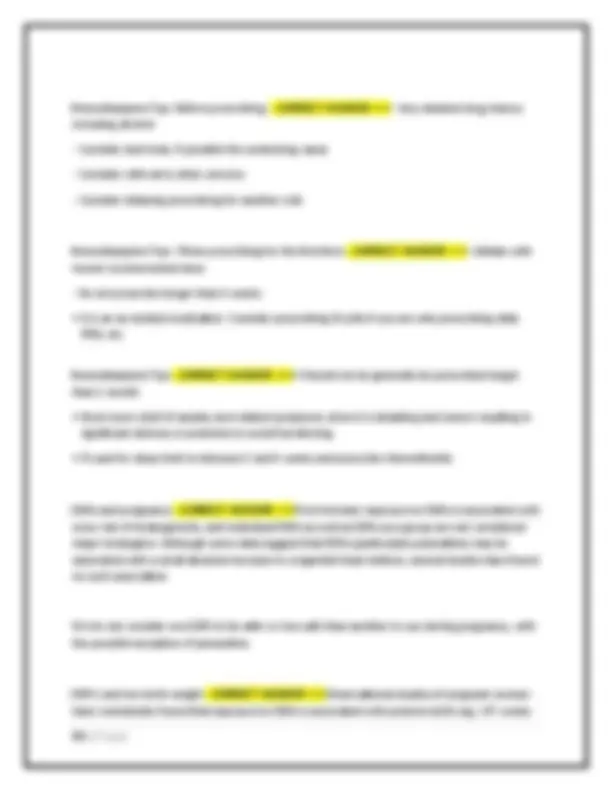
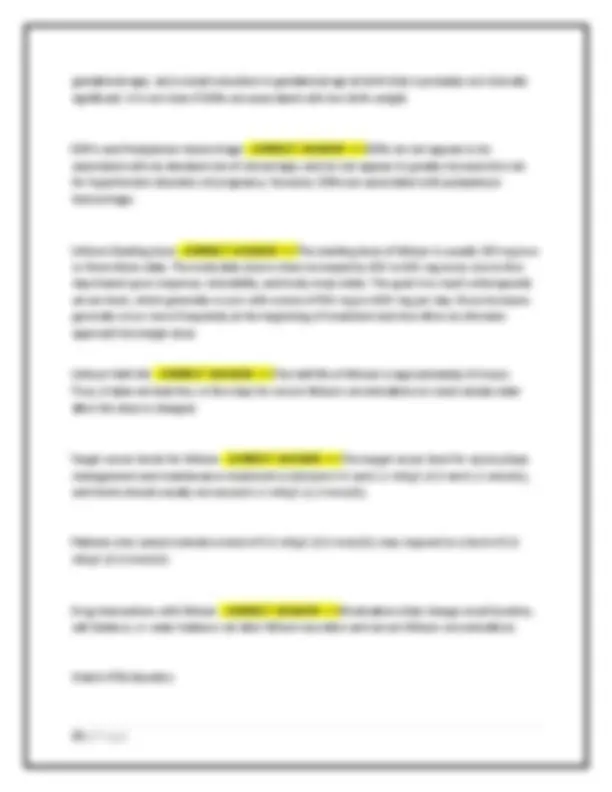
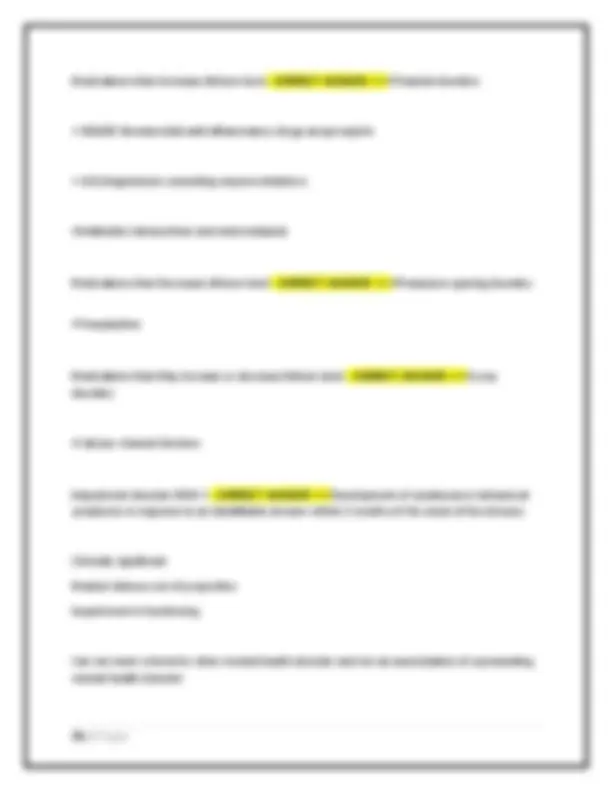
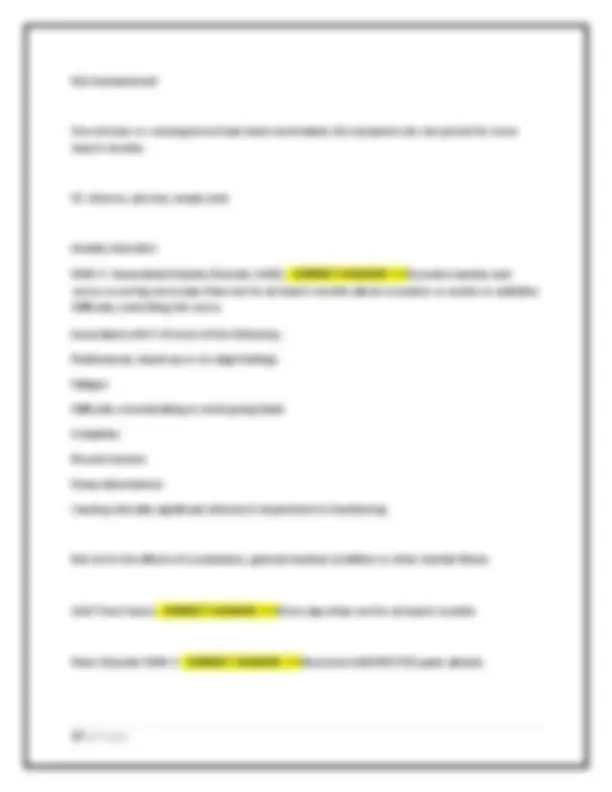
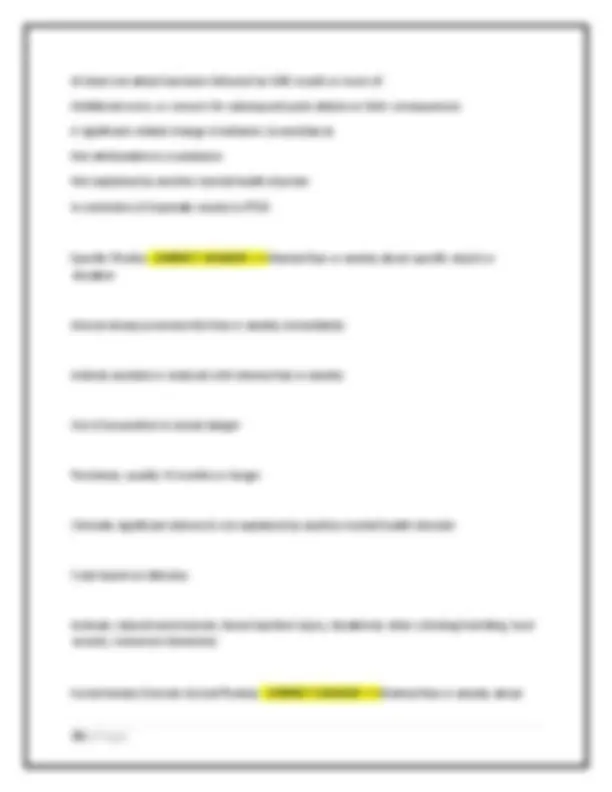
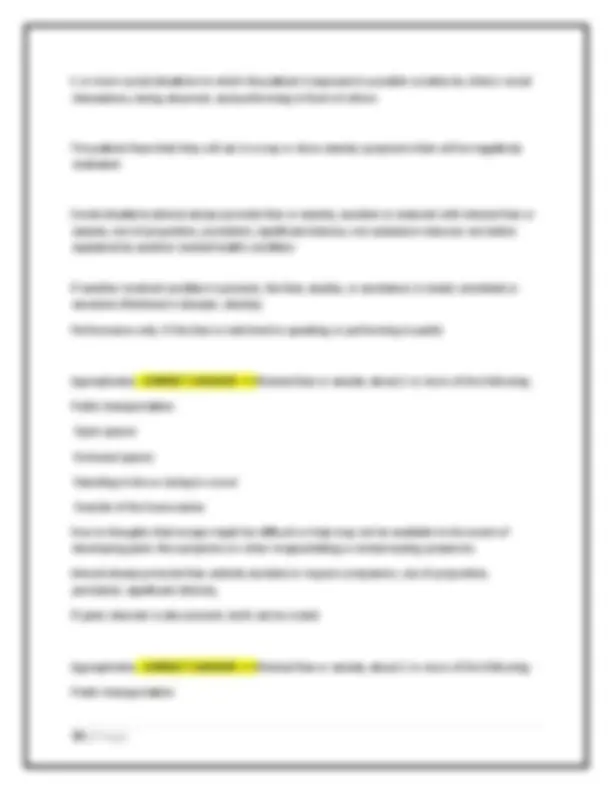
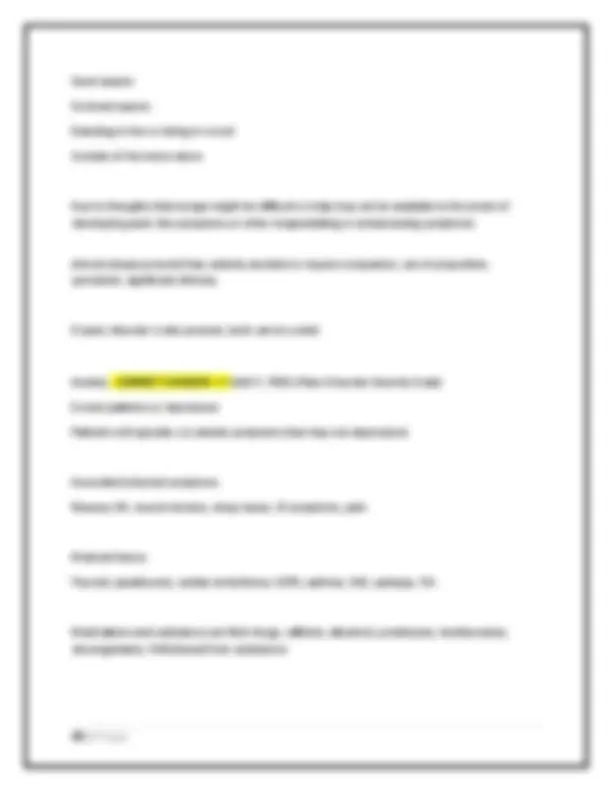
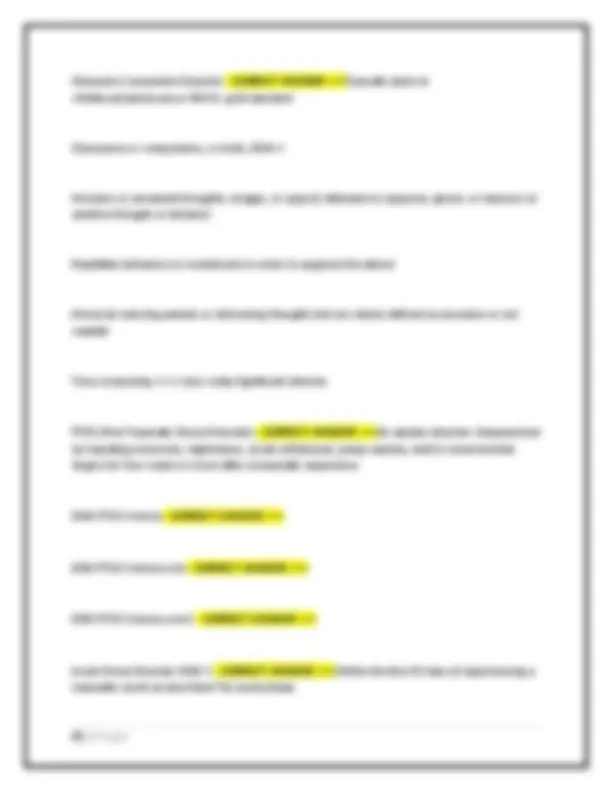
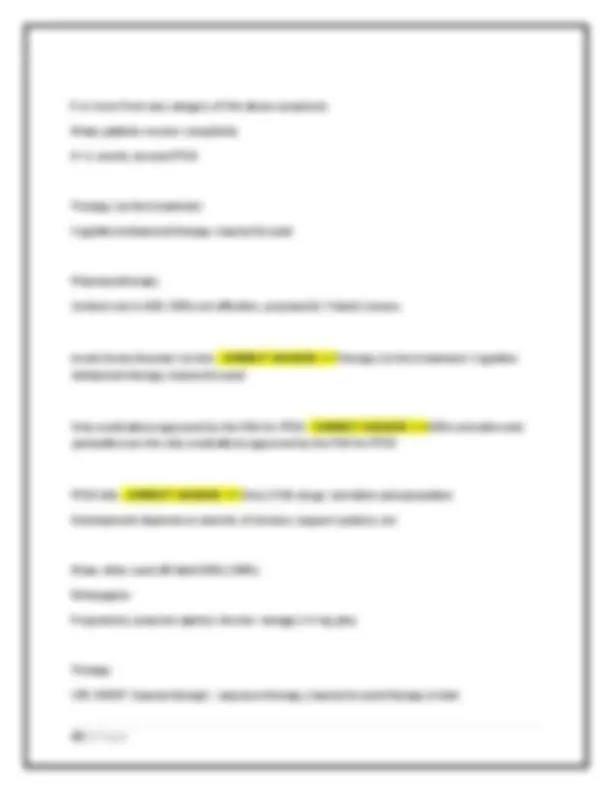
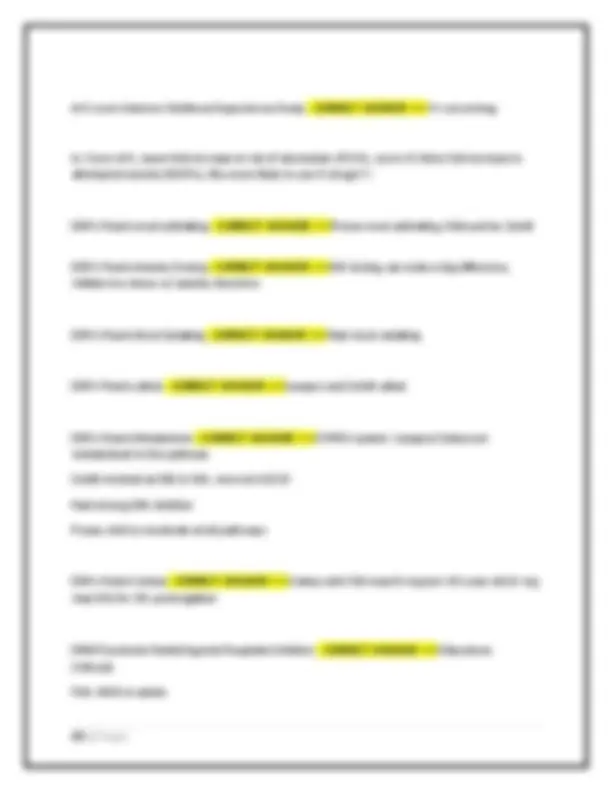
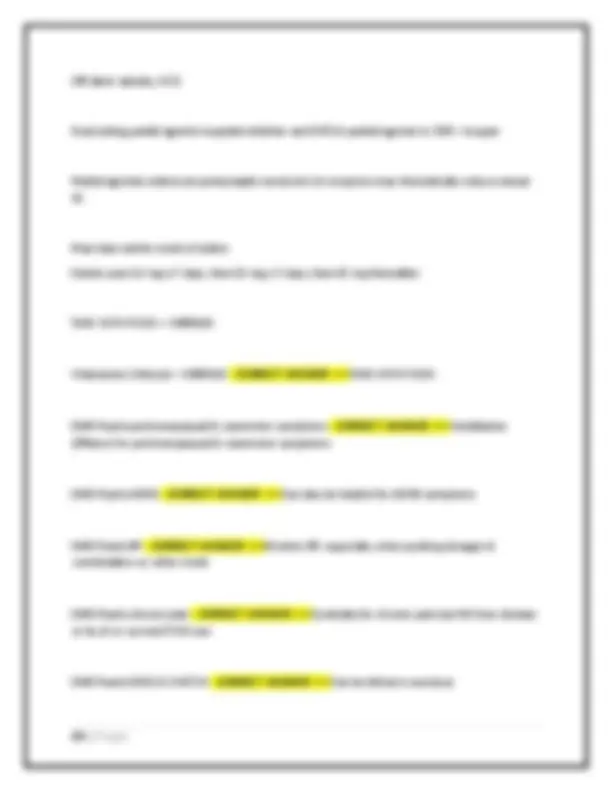

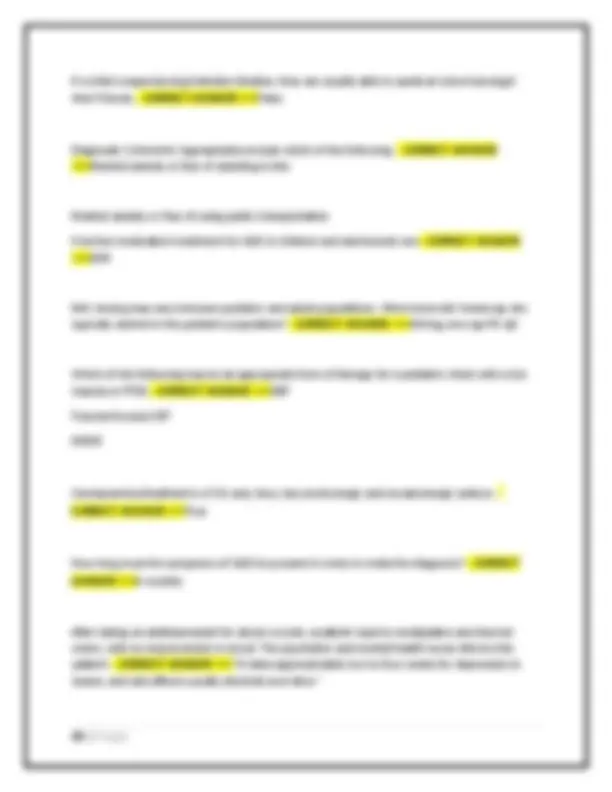
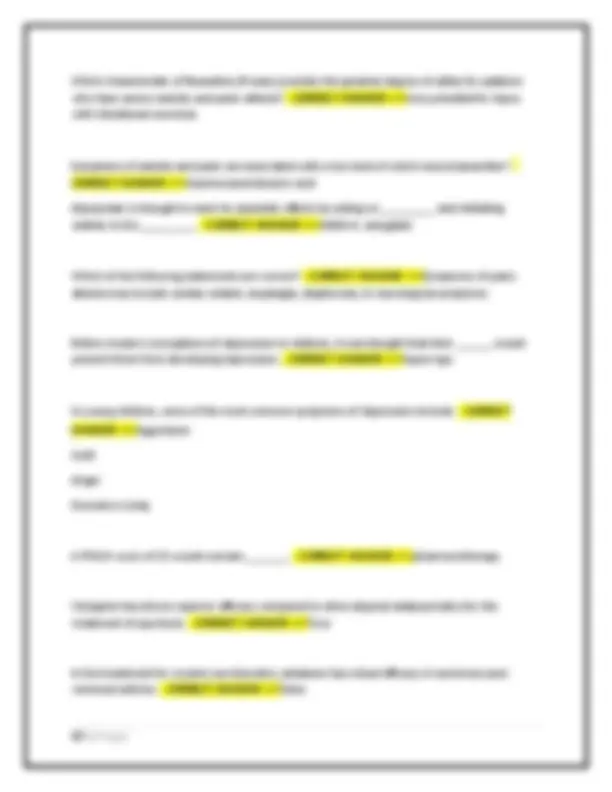
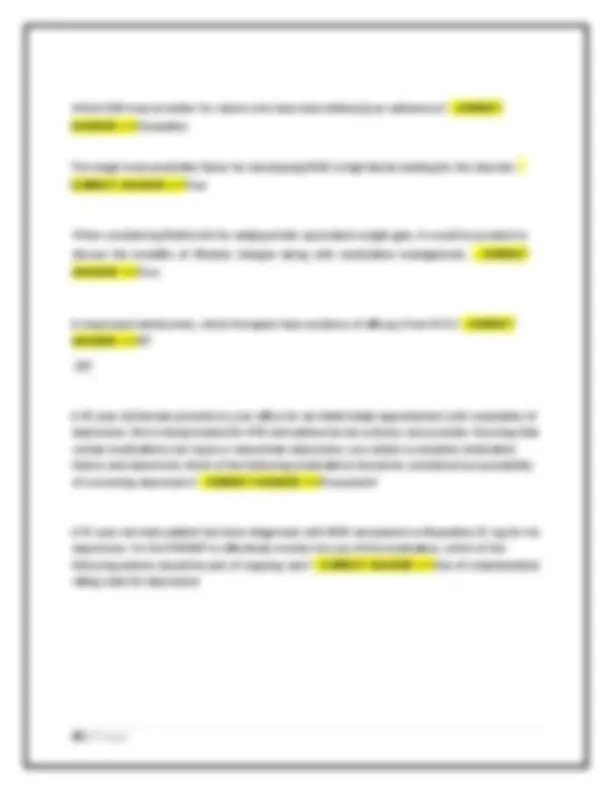


Study with the several resources on Docsity

Earn points by helping other students or get them with a premium plan


Prepare for your exams
Study with the several resources on Docsity

Earn points to download
Earn points by helping other students or get them with a premium plan
Community
Ask the community for help and clear up your study doubts
Discover the best universities in your country according to Docsity users
Free resources
Download our free guides on studying techniques, anxiety management strategies, and thesis advice from Docsity tutors
PMHNP 7348.01 FINAL EXAM NEWEST ACTUAL EXAM COMPLETE 250 QUESTIONS & CORRECT ANSWERS (WELL VERIFIED) GRADED A+
Typology: Exams
1 / 68

This page cannot be seen from the preview
Don't miss anything!





























































Which of the following is true regarding psychostimulants? - CORRECT ANSWER >>> First line treatment for ADHD Stimulants are first line treatment for ADHD in children, adolescents and adults. They are the most studied (Dulcan). ll of the following are changes that were made to the DSM V regarding ADHD? - CORRECT ANSWER >>> Changed age of onset to 12 CAN have Autism and ADHD and added symptoms across the lifespan since we know ADHD does not go away Can have ADHD and ODD comorbid. Also included in DSM under ADHD comorbidity- discusses that ADHD and ODD are comorbid 50% of the time modifiers were added so that the severity of the disorder (i.e., mild, moderate, or severe) can be specified and the disorder can be coded as "in partial remission" ADHD treatment is associated with a ... - CORRECT ANSWER >>> Decrease in accidental injury and medical utilization due to accidents and trauma
Stimulants have a black box warning for: - CORRECT ANSWER >>> Drug Dependence The U.S. Food and Drug Administration (FDA) reviewed the prescribing information on stimulants in an effort to clarify risks and benefits. After this careful review, the only black box warning for stimulants concerns their abuse potential" Screen for cardiac concerns. Which of the following is true regarding cortical brain development in children with ADHD compared to healthy controls? - CORRECT ANSWER >>> The timing of cortical maturation is different Peak thickness of cortex delayed (typically occurs around 7, may not happen until 10 for kids with ADHD) Paroxetine (Paxil) and atomoxetine (Strattera) - CORRECT ANSWER >>> Paroxetine (Paxil) is an inhibitor of CYP450 2D6 and atomoxetine (Strattera) is metabolized by CYP450 2D6, so the dose of atomoxetine should be decreased. Strattera as it is metabolized (get rid of d and c)by the P450 CYP 2D6, which many other psychiatric medications are also metabolized by. Specifically if you look under epocrates for interactions you will find "avoid combo, combo may increase atomoxetine levels, risk adverse effects" therefore you'd want to decrease the Strattera dose (or not use the combo) Which of the following is a risk factor for the development of Conduct Disorder - CORRECT ANSWER >>> Poor family functioning child maltreatment, overly harsh and abusive parenting or inconsistent parenting, neglectful parenting Which of the following symptom is the MOST frequent reason for referral in child psychiatry clinics? - CORRECT ANSWER >>> Disruptive behavior
Dextrostat (Dextroamphetamine) 5, 10 mg cap - CORRECT ANSWER >>> Typical Starting Dose > y: 5 mg q.d.-b.i.d Amphetamine preparations long acting considerations - CORRECT ANSWER >>> Longer acting stimulants offer greater convenience, confidentiality, and compliance with single daily dosing but may have greater problematic effects on evening appetite and sleep Adderall XR cap may be opened and sprinkled on soft foods Amphetamine x3 preparations long acting - CORRECT ANSWER >>> Dexedrine Spansule 5, 10, 15 mg cap Adderall XR 5, 10, 15, 20, 25, 30 mg cap Lisdexamfetamine (Vyvanse) 30, 50, 70 mg cap Dexedrine Spansules (dextroamphetamine) 5, 10, 15 mg cap - CORRECT ANSWER >>> Typical Starting Dose >6 y: 5-10 mg q.d.-b.i.d FDA Max 40 mg Off Label Max Daily >50 kg/100lb: 60 mg ADDERALL (XR), amphetamine and dextroamphetamine salts 5, 10, 15, 20, 25, 30 mg cap - CORRECT ANSWER >>> Typical Starting Dose >6 y: 10 mg q.d FDA Max 30 mg
Off Label Max Daily >50 kg/100lb: 60 mg Lisdexamfetamine (Vyvanse) 30, 50, 70 mg cap - CORRECT ANSWER >>> Typical Starting Dose 30 mg q.d. FDA Max 70 mg Methylphenidate preparations Short-acting considerations **- CORRECT ANSWER
** Shortacting stimulants often used as initial treatment in small children (<16 kg/32lb) but
have disadvantage of b.i.d.-t.i.d. dosing to control symptoms throughout day Methylphenidate x3 preparations Short-acting - CORRECT ANSWER >>> Focalin 2.5, 5, 10 mg cap Methylin 5, 10, 20 mg tab Ritalin 5, 10, 20 mg Focalin 2.5, 5, 10 mg cap - CORRECT ANSWER >>> dexmethylphenidate Typical Starting Dose 2.5 mg b.i.d. FDA Max 20 mg Off Label Max Daily 50 mg Methylin 5, 10, 20 mg Tab - CORRECT ANSWER >>> Typical Starting Dose 5 mg b.i.d.
FDA Max 60 mg OFF Label Max Daily >50 kg: 100 mg Methylin ER 10, 20 mg cap - CORRECT ANSWER >>> Typical Starting Dose 10 mg q.a.m. FDA Max 60 mg OFF Label Max Daily >50 kg: 100 mg Ritalin SR 20 mg - CORRECT ANSWER >>> Typical Starting Dose 10 mg q.a.m. FDA Max 60 mg OFF Label Max Daily >50 kg: 100 mg Metadate CD 10, 20, 30, 40, 50, 60 mg - CORRECT ANSWER >>> Typical Starting Dose 20 mg q.a.m. FDA Max 60 mg OFF Label Max Daily >50 kg: 100 mg Ritalin LA 10, 20, 30, 40 mg - CORRECT ANSWER >>> Typical Starting Dose 20 mg q.a.m. FDA Max 60 mg
OFF Label Max Daily >50 kg: 100 mg Long acting x3 Methylphenidate preparations - CORRECT ANSWER >>> Concerta 18, 27, 36, 54 mg cap Daytrana patch 10, 15, 20, 30 mg patches Focalin XR 5, 10, 15, 20 mg cap Long acting x3 Methylphenidate preparations considerations **- CORRECT ANSWER
** Swallow whole with liquids Nonabsorbable tablet shell may be seen in stool. Methylphenidate Immediate Release Duration - CORRECT ANSWER >>> Immediate Release Rule of Thumb 3- 4 Ritalin 3- 4 Methylin 3- 4 Focalin 3- 4 Methylphenidate Extended Release Duration - CORRECT ANSWER >>> Extended Release Rule of Thumb 8- 12 Ritalin SR 8 Concerta 12 Metadate 12 CD 8 Metadate ER 8 Ritalin LA 8- 12 Daytrana 8- 12
Daytrana patch 10, 15, 20, 30 mg patches - CORRECT ANSWER >>> Typical Starting Dose Begin with 10 mg patch q.d., then titrate up by patch strength FDA MAX 30 mg OFF Label Max Not yet known Focalin XR 5, 10, 15, 20 mg cap - CORRECT ANSWER >>> Typical Starting Dose 5 mg q.a.m FDA MAX 30 mg OFF Label Max 50 mg Selective Norepinephrine Reuptake Inhibitors (SNRIs) for ADHD **- CORRECT ANSWER
** Atomoxetine Strattera 10, 18, 25, 40, 60, 80, 100 mg cap Atomoxetine Strattera 10, 18, 25, 40, 60, 80, 100 mg cap - CORRECT ANSWER >>> Typical Starting Dose Children and adolescents <70 kg/140lb: 0.5 mg/kg/day for 4 days; then 1mg/kg/day for 4 days; then 1.2 mg/kg/day FDA MAX Lesser of 1.4 mg/kg or 100 mg
OFF Label Max Daily Lesser of 1.8 mg/kg or 100 mg Atomoxetine (Strattera) - CORRECT ANSWER >>> - BBW
Risk of suicidal ideation; monitor for suicidal thinking or behavior, worsening, or unusual
behavior
Glaucoma, pheochromocytoma, MAO I use within past 14 days
Rare, but severe hepatotoxicity (most within 120 days of start of treatment) SE Headache, insomnia, somnolence, dry mouth, nausea, abdominal pain, decrease in appetite, nausea, etc. Priapism NOTE
- do not open capsule * - irritant CYPD 2D6 substrate watch out for *LIVER PROBLEMS * Selective Norepinephrine Reuptake Inhibitors (SNRIs) for ADHD considerations - CORRECT ANSWER >>> Not a schedule II medication Consider if active substance abuse or severe side effects of stimulants (mood lability, tics); give q.a.m. or divided doses b.i.d. (effects on late evening behavior); do not open capsule; monitor closely for suicidal thinking and behavior, clinical worsening, or unusual changes in behavior
Dextroamphetamine Immediate Release Duration - CORRECT ANSWER >>> Immediate Release Rule of Thumb 3- 4 Dexedrine 3- 4
Common Stimulant Side Effects - CORRECT ANSWER >>> Stomachaches, headaches, nausea
Max: 100 mg/day; Info: may incr. to 100 mg/day after 2-4wk; in CYP2D6 poor metabolizers, start 40 mg PO qam x4wk; do not open cap; periodically reassess need for tx Atomoxetine (Strattera) Pediatric dosing and dose form [6 yo and older, <70 kg] - CORRECT ANSWER >>> 6 yo and older, <70 kg Dose: 1.2 mg/kg/day PO divided qd-bid Start: 0.5 mg/kg PO qam for at least 3 days; Max: 1.4 mg/kg/day; Info: in CYP2D6 poor metabolizers, start 0.5 mg/kg PO qam x4wk; do not open cap; periodically reassess need for tx Atomoxetine (Strattera) Pediatric dosing and dose form 6 yo and older, >70 kg - CORRECT ANSWER >>> Dose: 80 mg/day PO divided qd-bid Start: 40 mg PO qam for at least 3 days; Max: 100 mg/day; Info: may incr. to 100 mg/day after 2-4wk; in CYP2D6 poor metabolizers, start 40 mg PO qam x4wk; do not open cap; periodically reassess need for tx Non-Stimulant Medications Atomoxetine (Strattera) - CORRECT ANSWER >>> • Norepinephrine uptake inhibitor (selective inhibition of presynaptic norepinephrine transporter) so increases DA and NE in prefrontal cortex
Blurts out answers Difficult waiting turn Interrupts or intrudes Inattention criteria ADHD - CORRECT ANSWER >>> Fails to give close attention to details or makes careless mistakes in schoolwork, at work, or during other activities Difficulty sustaining attention in tasks or play activities Does not seem to listen when spoken to directly Does not follow through on instructions and fails to finish schoolwork, chores, or duties in the workplace Difficulty organizing tasks and activities Avoids, dislikes, or is reluctant to engage in tasks that require sustained mental effort Often loses things necessary for tasks or activities Easily distracted by extraneous stimuli Forgetful in daily activities Diagnosis of ASD 2 Major Categories - CORRECT ANSWER >>> 2 Major Categories A. Persistent deficits in social communication and social interaction across multiple contexts B. Restrictive and repetitive behaviors and/or stereotyped patterns of interest that are abnormal in their intensity of focus ASD: Social Communication and Social Interaction Deficits (manifested by all of the following) x
- CORRECT ANSWER >>> 1) Deficits in social-emotional reciprocity
ASD: Insistence on sameness, inflexible adherence to routines, or ritualized patterns of verbal or nonverbal behavior - CORRECT ANSWER >>> e.g., extreme distress at small changes, difficulties with transitions, rigid thinking patterns, greeting rituals, need to take same route or eat same food every day. ASD: Highly restricted, fixated interests that are abnormal in intensity or focus - CORRECT ANSWER >>> e.g., strong attachment to or preoccupation with unusual objects, excessively circumscribed or perseverative interests. ASD: Hyper- or hyporeactivity to sensory input or unusual interest in sensory aspects of the environment - CORRECT ANSWER >>> e.g. apparent indifference to pain/temperature, adverse response to specific sounds or textures, excessive smelling or touching of objects, visual fascination with lights or movement. Social (Pragmatic) Communication Disorder - CORRECT ANSWER >>> Persistent difficulties in the social use of verbal and nonverbal communication New diagnosis for DSM V to capture children who do not have stereotyped or restricted interests Diagnosis of Social (Pragmatic) Communication Disorder x4 - CORRECT ANSWER >>> 1) Persistent difficulties in the social use of verbal and nonverbal communication as manifested by all of the following